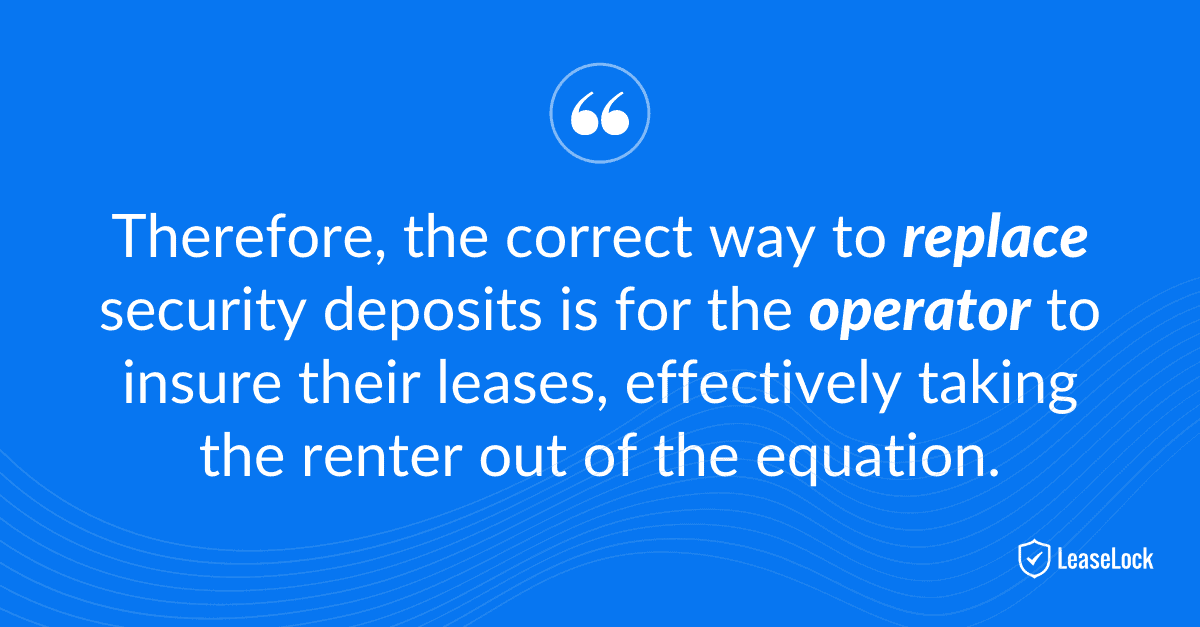The Growing Risk of Deposits and Deposit Alternatives
In our last blog, we discussed how operators are reducing bad debt by insuring leases instead of taking security deposits. The bad debt that we discussed in that post ought to be enough to motivate any operator to rid themselves of deposits for good — but it is not the only reason to do it.
For operators, security deposits are becoming more burdensome and risky. For residents, some of the alternatives to security deposits are introducing new types of risk. Below, we will seek to understand these risks and how to avoid them.
Security Deposits Are Getting Less Secure
An increasing number of state and city legislatures are adopting laws that mandate that apartment operators offer an alternative to a security deposit (nicknamed “Renters Choice” laws). The intent of these laws is to make rental housing more affordable, which is, of course, a good thing. As with most legislation, however, the devil is in the details.
The laws implemented by states and municipalities apply multiple restrictions to security deposits and vary substantially from legislature to legislature. Some limit the maximum size of a deposit or restrict the window in which deposit refunds must be distributed. In some cases, the laws require operators to offer deposit installment plans. We will not go any deeper into individual laws in this post, but visit the deposit laws section of our blog for more details.
It is not hard to imagine how quickly the rules pile up for a multifamily operator with communities in more than one city. Each new law creates a need for a policy change by the operator, and each policy change adds complexity to the process of deposit administration. The added complexity costs time and increases the likelihood that a property may fail to comply with a new law, resulting in potential lawsuits. As one senior leader of a major multifamily operator recently told us, “we are now being sued every week over $500 deposits.”
The growing risk and administrative burden of deposits is a concern already on the radar of most operators. A growing number are looking to find deposit alternatives, often because the laws say that they have to. But what relatively few operators understand is the new risk associated with some popular forms of deposit alternative.
Read the Fine Print!
A recent article in urban development publication Shelterforce summarized the developing story of deposit alternatives. It’s a story that multifamily operators should take the time to understand. “Renters Choice” laws have been becoming more frequent but are still relatively new (Cincinnati’s was the first, dating back to April 2020).
Because the legislation is recent, the level of understanding about how some deposit alternatives work is still relatively low. For example, only the most diligent renters will spot that the products being marketed directly to them as “insurance” actually leave them exposed to substantial risk. The article points out how most security deposit alternatives do not provide renters with protection from claims, adding “tenants using products like Rhino remain fully liable for any claims paid to their landlords.”
Although deposit alternatives are marketed as “insurance products,” in reality, they are “surety bonds,” i.e., they guarantee the bonded party’s contractual obligations (the renter’s financial obligations to their landlord). Unlike insurance products, the premium paid to the provider does not guarantee a level of coverage. Rather, if the landlord files a claim, the bond company pays the landlord but may then seek repayment from the renter. Given that the product is marketed to the resident as an “insurance” product, this comes as an unpleasant surprise, especially since it can impact their credit score.
Why Partial Solutions Don’t Help
The best way for operators to avoid the problems described above is to replace deposits with insurance. Replacing deposits, rather than just offering an alternative, means driving the highest possible participation in a true insurance program. High participation minimizes the number of leases subject to deposits and the associated risk and workload. Deposit alternative products tend to have relatively low, usually less than 50% adoption rates, which leaves most leases unchanged.
Insurance exists to shift risk from the policyholder to the carrier, and this is not how surety bonds work. In considering deposit alternatives, many operators misunderstand that it is their risk that is being covered (not the renter’s). Therefore, the correct way to replace security deposits is for the operator to insure their leases, effectively taking the renter out of the equation.
As we mentioned in our last post, operators can recoup the cost of the insurance from the resident by offering them an insurance waiver product (usually a small monthly fee that covers the cost that the operator is paying to insure the lease). The critical difference with this arrangement is that the fee is a transaction between the renter and the landlord, and does not make the renter liable for claims in the way that surety bonds do.
Through true lease insurance, rather than surety bonds, operators can maximize coverage while removing the possibility of the provider collecting on a resident after move-out. This has important implications for resident experience, which is a topic to which we cover in our next post.





